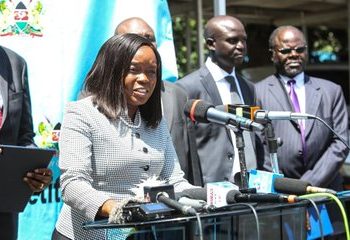An African-led initiative, which aims at ending HIV in children and adolescents by 2025 in regional countries, has been launched.
The initiative, which assembles a coalition of partners, is led by Africa REACH and includes the Desmond Tutu Health Foundation, the All-Africa Council of Churches, the Organization of African First Ladies for Development, Pediatric-Adolescent Treatment Africa and the African HIV Control Working Group.
The partners plan to bring together organization and individuals to support the goal of ending Aids in children and adolescents by 2025 through advocacy, policy influence and resource mobilisation.
The coalition has identified African government leaders at all levels—from Heads of State to Ministers of Health, as well as technical teams working on HIV programming and funding in countries, to prioritise optimal HIV prevention and treatment among children and adolescents in the region.
Speaking in Nairobi, on October 3, Ms Sonia Ndimbiri, Africa REACH lead noted: “Although significant progress has been made over the last 15 years in preventing vertical transmission of HIV in Africa where Antiretroviral therapy (ART) coverage for pregnant women and breastfeeding women living with HIV has risen from 48 per cent in 2010 to 82 per cent in 2022, reaching 93 per cent in eastern and southern Africa.
“However, recent years have seen a slowdown in the rate of reduction in new HIV infections in children, partly due to around 20 per cent of expectant mothers living with HIV not receiving ART in 2022, totaling 220,000 women,”.
Ms Ndimbiri added: “Improving ART coverage in this group and addressing treatment gaps in children presents a crucial opportunity to further reduce paediatrics HIV infections and end Aids in children,”.
According to experts, in 2022, 210,000 adolescent girls and young women acquired HIV at a rate of 4,000 new infections per week, accounting for over 60 per cent of new HIV infections in Africa.
In 2022, for example, UNICEF data identified treatment gaps in children with treatment coverage among adults (15 years and older) at 77 per cent compared to 57 per cent among children (0-14 years).
This data offers an important opportunity to prevent new infections and improve treatment access.
Speaking during the occasion, a Public health advisor to the President and Cabinet of Zimbabwe, Dr Agnes Mahomva urged regional governments to prioritise collaboration with partners in reducing paediatric HIV in Africa.
“Let us all embrace policies which have realised a significant achievement in reducing paediatric HIV infections in various countries in the region.
“By working together, we shall be able to respond to our specific country needs towards the realisation of our goals,”.
At the same time, Dr Mahomva challenged African countries to mobilise the required domestic funding in the fight against HIV in children and adolescent warning that reliance on donor-funding was dwindling.
“If we keep on relying on donors such as the Global Fund and others and they halt the funding, our programmes to fight HIV among children and adolescents will be adversely affected.
“We, therefore, want African governments to allocate adequate budgetary allocation to the Health sector to ensure HIV programmes do not grind to halt,” Dr Mahomva observed.
Earlier, the President and Chief executive, Elizabeth Glaser Paediatric Aids Foundation Chip Lyons said there was need for “political seriousness” in ending HIV in Kenya, other African countries and globally including in the USA.
“Kenya, for example, is widely regarded as one of sub-Saharan Africa’s HIV prevention success stories with annual new HIV infections less than a third of what they were at the peak of the country’s epidemic in 1993.
“However, the challenge facing Kenya—and other countries—is how to ensure new HIV infection rates are kept down as Aids has no cure nor vaccine,”.
Mr Lyons noted: “At the same time, we need to take cognizance of what would happen if the US President’s Emergency Plan for Aids Relief (Pepfar)—which is funded by US taxpayers, exits the scene,”.
According to experts, Kenya is on the verge of achieving the UNAIDS 95-95-95 targets (95 per cent of people with HIV diagnosed; 95 per cent of them on ART and 95 per cent of them viral suppressed) and Pepfar is focusing on key and priority populations including young men and women under 30 years with critical HIV services to close critical gaps.















